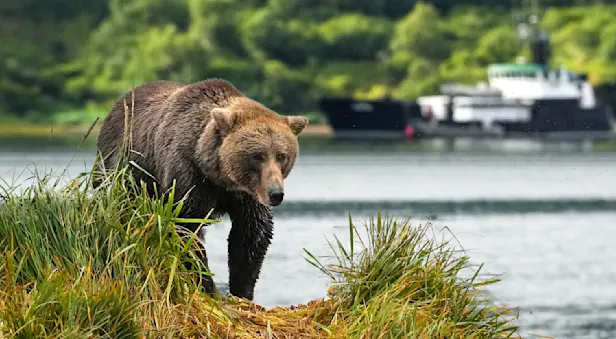
Know Before You Go


Grizzly Bear Facts | British Columbia Wildlife Guide
Physical Characteristics
Grizzly bears belong to the family Ursidae in the order Carnivora. Previously, brown bears and grizzlies were labeled as individual species by taxonomists. However, these two bears are technically the same species, classified as Ursus arctos.
In British Columbia, all members of the species are referred to as grizzly bears regardless of where they live. In Alaska, however, the term “grizzly” refers to interior bears, because of their white-tipped back fur and shoulders covered in lengthy guard hairs, which give them a “grizzled” appearance. Coastal species that rely on salmon as their main source of nutrition are typically called “brown bears.”
While the grizzly bear closely resembles the black bear, Ursus americanus, there are some major differences. The body size of a grizzly bear is bulkier and has a prominent shoulder hump, smaller ears, and larger, straighter claws. The grizzly bear adapted longer claws and larger hump for feeding purposes. Claws help grizzly bears dig for roots and unearth animal burrows. The muscular shoulder hump helps them dig and attain short bursts of speed for catching loping caribou and moose.
Grizzly and black bears’ fur can be a variety of shades, making color an unreliable identifier for differentiating between species. A black bear’s fur ranges from dark brown to cinnamon-tinged red to blueish grey and white. Grizzly bears occur in hues of brown and blond.
Grizzly bears, along with polar bears, are the largest of the bear species. Grizzly bear size, however, varies with different populations according to the available food supply. Identifying the weights of certain populations is challenging because heaviness varies widely depending on the season. Bears can double their weight during fall when they are foraging and preparing for winter hibernation, compared to being leaner in the spring. An adult male typically weighs between 300 to 900 pounds, and females weigh between 205 and 455 pounds.
Grizzly bears from British Columbia are about one-third larger than their inland cousins of Europe, North America and the sub-Arctic, likely due to their abundant food supply of protein-heavy salmon and rich berries. British Columbia, the Alaskan and Katmai coasts, and their adjacent islands such as Kodiak and Admiralty, are home to the largest grizzly bears. Here, mature males can attain an enormous size, weighing up to 1,700 pounds, with their female counterparts weighing up to 700 pounds. An extremely large grizzly bear may have a skull 18 inches long and 12 inches wide. Such a bear, when standing on its hind feet, is about 9 feet tall.
Grizzly bears possess an amazing sense of smell. They are likely able to detect scents from miles away, especially downwind. Their ability to hear and see is about the same as humans. Bears will stand erect on their hind paws in order to gain a better view of the land and to better catch scents on the wind. Grizzly bears are opportunistic hunters. They and are immensely clever and resourceful, which allows them to adapt to a number of habitats.
Habitat & Distribution
Grizzly bears live in a broad range of ecosystems, including subalpine mountain regions, the icy tundra and thickly wooded forests. They once roamed the North American Great Plains but have since vanished due to human encroachment. The grizzly bear has the widest distribution and range of any bear species on earth. They are found in scattered groups throughout Europe and Asia. In North America, they are found primarily in Alaska and western Canada, with small populations in Washington, Montana, Idaho and Wyoming.
Home Ranges
Grizzly bears establish home ranges, which are not technically considered territories because grizzlies will not guard boundaries from one another. The exception comes when a bear feels his exclusive access to a limited resource, such as a rich berry bush, carrion or a kill is worth the risk of vehemently defending. For the most part, however, guarding such an expansive range is impossible, as these bears journey across great stretches of land to find nutrient-rich foods, traveling to different food sites as the seasons change.
The annual home ranges of bears vary greatly in form and size, depending on topography and the food sources contained within them. As adult males range widely during the mating season in search of sows in estrus, their home ranges are substantially larger than those of females.
Bear Behavior
Grizzly bears typically search for food during morning and evening hours, though they can be active at any time. During the day, they like to dig slight depressions in the ground to rest in. These “day beds” are usually under the cover of dense foliage or geological formations. In the fall, grizzly bears will journey miles to forage at their favorite berry sites and salmon streams.
Bears are solitary animals, living neither in herds nor packs, thus social contact between individual animals is relatively limited. Because there is no need for communication beyond the very basics, the animals lack a complex body language, and the ability to vocalize is limited to a narrow range of sounds. Thus, the requisite muscles for facial expressions are poorly developed. The ears are small and unsuited to impart a visual signal, and the tail is a short stump and not at all useful for conveying messages.
Consequently, due to these physical limitations, the communication of bears is more straightforward than in many other animals.
Grizzly bears react upon threat without much ado and are therefore considered unpredictable. However, this is an inaccurate depiction of the species. Bears do give signals, yet often they are misinterpreted or not recognized as such. Frequently, nervous bears yawn, which erroneously is regarded as the reaction of a bored individual. In addition, a bear experiencing extreme stress may be foaming at the mouth, which indicates the animal is walking the thin line that separates flight and fight. Such signals actually indicate that the so-called magic circle of a bear—a personal space of individual diameter—is violated. Any transgression of a bear’s private sphere results either in the withdrawal of the animal or in the forceful removal of the intruder.
Although the communication skills are somewhat restricted, bears are still extremely adaptable animals and curious by nature. They inspect their environment at all times, a behavior that plays an important part in the search for food. In fact, during experiments performed in zoos, it was found that bears investigated objects, such as toys, in their enclosures more intensely and for a longer time than did primates. Every individual bear has a character of its own.
Distinct animals react differently to environmental stimuli, and depending upon its emotional state of mind at the time, the same bear may display diametrically opposite behavior in similar situations. Due to their individuality, it is difficult to give advice on how to react upon encountering a bear. Grizzly bears are endowed with great physical strength, speed and agility, so human behavior in bear country should aim toward avoiding confrontation. This can be achieved most effectively if provisions are treated with utmost care and are stored properly so that bears cannot get to them. Food should never, under any circumstances, be stashed in or near a tent.
As surprised or frightened animals sometimes act according to the motto that attack is the best possible mode of defense, one is strongly advised to walk through the wilderness with eyes wide open and ears pricked, talking or singing loudly in places of low visibility to announce their presence. As a rule, bears show little interest in people and do not consider humans as potential prey.
However, we should never forget that we are guests in bear country, and as such, we should show respect for these animals. Ideally, the impact of our presence should not be felt. Bears should be able to pursue their activities undisturbed at all times. The best photographic opportunities arise when the bears are relaxed, totally ignoring us. If we act obtrusively, they will become nervous and wander off.
Biology & Feeding Habits
Bears are unusual members of the order Carnivora. Only polar bears do justice to the standard conception of carnivores by predominantly leading the life of a predator, hunting seals and other marine mammals. In the nourishment of all other bear species, meat or fish is of minor significance.
The diet of most grizzly bears can be more than 80 percent vegetarian. However, coastal brown bears are an exception to this rule. They stuff themselves with salmon during the summer, and plants play a much smaller role in their feeding habits. In the spring, even the bears in British Columbia are forced to rely on flowers, grasses, and roots for sustenance, as no other foods are available. In the fall, the bears on most parts of the peninsula feed on blueberries, soapberries or cranberries.
The nourishment of bears defies generalization, as these animals are highly opportunistic in their feeding habits; they utilize every resource available. Bears eat carrion and will dispossess other carnivores of their prey. Despite their huge bulk and ungainly appearance, they are successful hunters. In some areas, as much as 40 percent of all moose and caribou calves fall victim to grizzly bears.
The large vegetarian component of the bear’s diet does not seem to agree with our preconceived image of a predator. On the basis of their food preferences, their ancestors would have matched our image of a carnivore much better. Most of the living members of the family Ursidae can be traced back to a small, foxlike creature that lived about 5 to 10 million years ago. In the course of evolution, morphological characteristics developed that enabled the animals to concentrate increasingly on plants and vegetables in their diet.
In contrast with specialized carnivores, bears have a greater number of molar teeth, which are also enlarged and cusped to mince up grasses and roots. As it is much more difficult to extract energy from plant matter than flesh, the intestines of bears, in relation to body length, are much longer than those of wolves or lions. However, their digestive tract is still short when compared with ruminants such as cows or sheep. Bears also lack the support of the necessary symbiotic microorganisms, and thus they are unable to break down the cellulose in plant cell walls.
Predators always live between the extremes: periods of gluttony alternated with times of hunger. After a meal, days may pass before a new kill is made. Thus, many predators supplement their diet to a minor degree with vegetation, especially fruit. Bears have made this former dietary addition their main course. The success of the omnivorous nourishment shows is revealed in the family Ursidae. They are substantially bigger than their ancestors. Jointly with the polar bear, these gargantuan animals are the largest terrestrial carnivores in the world.
Due to their mass and their diet, bears differ greatly from typical carnivores such as cats and dogs. For instance, bears walk on the soles of their hindfeet—a posture called plantigrade—whereas cats and dogs have digitigrade feet—where only the toes touch the ground. Digitigrade feet enable the animal to run faster by lengthening the stride. Bears, by contrast, are rather mediocre sprinters, despite the fact that they are able to move at speeds of up to 31 miles per hour. For a long-distance chase, they are much too heavy.
Their legs are relatively short but much more mobile than the limbs of typical runners. The mobility and strength of their limbs are of great importance for bears in their search for food, such as digging for roots. In addition, the animals may not be able to escape danger by fleeing; instead, they are quite capable of defending themselves by means of brute force.
Hibernation
In late fall, before the bitter cold of winter descends, grizzly bears enter dens and begin to hibernate. In the northern part of their distribution area, the animals may spend 60 percent of their lives in deep sleep. By contrast, during the mild winters in British Columbia, some boars do not retreat at all to protected quarters. However, these individuals show no exuberance either. Instead, they are relatively sedentary, making short movements and appearing at times extremely lethargic. During the worst weather, they spend their time sleeping, bedded underneath some trees or in the shelter of bushes.
Shortage of food is the driving force behind the retreat from active life. As the end of the year draws closer, the land provides less and less in terms of high-energy provisions. Eventually, the bears are unable to even remotely replace the calories burned in the search for food. Hence, there is an advantage to be gained from conserving energy by reducing all bodily functions to a minimum and letting metabolism burn on low flame.
Depending on gender, family status and age, bears enter their dens at different times. Pregnant females and sows with cubs are first, followed by sub-adults, and then adult females without progeny; the last to bed themselves to the long sleep are the dominant boars. In spring, the animals emerge in reverse order. Strong competition for the available resources in the months bordering winter is the reason for the variance in time spent in hibernation.
Research & Conservation
The number of grizzly bears in the wild has plummeted since the turn of the century. As settlers and their livestock journeyed farther west across America, the bears were pushed out of their homelands. Now, grizzlies inhabit less than 2 percent of their former range. Many threats continue to encroach on what is left of the bears’ habitat, including human development in the form of roads, houses, hotels and golf courses, in addition to mining and logging. Grizzly bear numbers in the continental United States have dropped from 100,000 in the early 1900s to fewer than 1,000. Thankfully, about 30,000 grizzly bears still roam the mountains of Alaska and western Canada.
Human Conflict
Knowledge of the world in which bears live helps us to better understand conflicts that arise between bears and humans, thus allowing us to take steps to prevent them, thereby protecting bears as well as ourselves. There are two major ways in which bears and people come into conflict. The first involves surprise, close-range encounters. If you suddenly encounter a bear at very close range, it is possible that the bear may not know whether you are a person or another bear. If it thinks you are a threat and that it cannot escape, it may believe that it will have to fight for its life in order to survive the encounter.
You should avoid such situations by being alert and making noise that any bear in the area will recognize as indicative of an approaching person. If the bear hears you coming, it will most likely move away to avoid you. If you do encounter a bear, help the bear to recognize that you are a person and not a threat. Back away slowly to give the bear more space. You could also raise your hands in the air and talk calmly (if you can speak) to the bear. Do not turn your back on the bear, and DO NOT RUN! This will only incite the bear to give chase.
Even if a nearby bear does not seem disturbed by your presence, keep in mind that, unlike people, bears are not sociable. Your presence can make it difficult for a bear to concentrate on fishing and may cause the bear to stop fishing and leave sooner than it otherwise would have. If you stay at least 50 yards from bears, you will make it easier for them to remain in that area. This will also help ensure that other people will continue to have opportunities to enjoy watching bears in the future.
The second major type of conflict arises when people allow a bear to obtain their food, thereby teaching it that they are a convenient source of nourishment. It is essential for people to keep their food away from these animals, in order to avoid human-bear conflicts.
After such an experience, the bear is likely to be attracted to people and may approach them aggressively with the hope that, by doing so, it will be rewarded with food. This situation is very dangerous and is likely to result in the eventual destruction of the bear in order to protect people. The only solution is to prevent the situation from developing in the first place. Recognize that a bear will eat any food that it discovers, and do your utmost to ensure that no bear obtains food from you or in any way associated nearby food with you.Header Credit:Melissa Scott
Encounter Bears & Whales On These Adventures

Great Bear Rainforest: In Search of Spirit Bears, Grizzlies & Whales
Discover British Columbia at its wildest, in search of the elusive white Spirit Bear in the remote valleys of western Canada's Coast Range. Offshore, scout for humpback whales and orcas in emerald fjords.


Alaska's Grizzly Ship: Kodiak to Katmai
An exclusive small-ship adventure to view giant brown bears—the world's largest "coastal grizzlies"—up close! Walk the shores as bears dig for clams, forage for sedges and pursue salmon in season in tidal streams.































